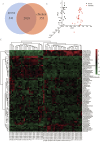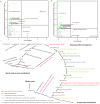Genome and metagenome analyses reveal adaptive evolution of the host and interaction with the gut microbiota in the goose
- PMID: 27608918
- PMCID: PMC5016989
- DOI: 10.1038/srep32961
Genome and metagenome analyses reveal adaptive evolution of the host and interaction with the gut microbiota in the goose
Abstract
The goose is an economically important waterfowl that exhibits unique characteristics and abilities, such as liver fat deposition and fibre digestion. Here, we report de novo whole-genome assemblies for the goose and swan goose and describe the evolutionary relationships among 7 bird species, including domestic and wild geese, which diverged approximately 3.4~6.3 million years ago (Mya). In contrast to chickens as a proximal species, the expanded and rapidly evolving genes found in the goose genome are mainly involved in metabolism, including energy, amino acid and carbohydrate metabolism. Further integrated analysis of the host genome and gut metagenome indicated that the most widely shared functional enrichment of genes occurs for functions such as glycolysis/gluconeogenesis, starch and sucrose metabolism, propanoate metabolism and the citrate cycle. We speculate that the unique physiological abilities of geese benefit from the adaptive evolution of the host genome and symbiotic interactions with gut microbes.
Figures



Similar articles
-
Metagenomic profiling of gut microbial communities in both wild and artificially reared Bar-headed goose (Anser indicus).Microbiologyopen. 2017 Apr;6(2):e00429. doi: 10.1002/mbo3.429. Epub 2016 Dec 20. Microbiologyopen. 2017. PMID: 27998035 Free PMC article.
-
Comparative analysis of the gastrointestinal microbial communities of bar-headed goose (Anser indicus) in different breeding patterns by high-throughput sequencing.Microbiol Res. 2016 Jan;182:59-67. doi: 10.1016/j.micres.2015.10.003. Epub 2015 Oct 23. Microbiol Res. 2016. PMID: 26686614
-
Comparative metagenomics of the gut microbiota in wild greylag geese (Anser anser) and ruddy shelducks (Tadorna ferruginea).Microbiologyopen. 2019 May;8(5):e00725. doi: 10.1002/mbo3.725. Epub 2018 Sep 17. Microbiologyopen. 2019. PMID: 30296008 Free PMC article.
-
Diversity and genomes of uncultured microbial symbionts in the termite gut.Biosci Biotechnol Biochem. 2010;74(6):1145-51. doi: 10.1271/bbb.100094. Epub 2010 Jun 7. Biosci Biotechnol Biochem. 2010. PMID: 20530908 Review.
-
Functional genomic and metagenomic approaches to understanding gut microbiota-animal mutualism.Curr Opin Microbiol. 2015 Apr;24:38-46. doi: 10.1016/j.mib.2015.01.007. Epub 2015 Jan 24. Curr Opin Microbiol. 2015. PMID: 25625313 Review.
Cited by
-
Comparative analysis of the intestinal microbiota of black-necked cranes (Grus nigricollis) in different wintering areas.Front Cell Infect Microbiol. 2024 Jan 22;13:1302785. doi: 10.3389/fcimb.2023.1302785. eCollection 2023. Front Cell Infect Microbiol. 2024. PMID: 38317791 Free PMC article.
-
Comparative proteomic analysis of pituitary glands from Huoyan geese between pre-laying and laying periods using an iTRAQ-based approach.PLoS One. 2017 Sep 25;12(9):e0185253. doi: 10.1371/journal.pone.0185253. eCollection 2017. PLoS One. 2017. PMID: 28945779 Free PMC article.
-
Spatial Organization of the Gastrointestinal Microbiota in Urban Canada Geese.Sci Rep. 2018 Feb 27;8(1):3713. doi: 10.1038/s41598-018-21892-y. Sci Rep. 2018. PMID: 29487373 Free PMC article.
-
Dietary and Sexual Correlates of Gut Microbiota in the Japanese Gecko, Gekko japonicus (Schlegel, 1836).Animals (Basel). 2023 Apr 16;13(8):1365. doi: 10.3390/ani13081365. Animals (Basel). 2023. PMID: 37106928 Free PMC article.
-
Pacific Biosciences assembly with Hi-C mapping generates an improved, chromosome-level goose genome.Gigascience. 2020 Oct 24;9(10):giaa114. doi: 10.1093/gigascience/giaa114. Gigascience. 2020. PMID: 33099628 Free PMC article.
References
-
- Chen G.-H. et al. Poultry genetic resources in China. Shanghai Scientific and Technological Press, Shanghai, Ch. 1, 25–28 China (2004).
-
- Rischkowsky B. & Pilling D. The state of the world’s animal genetic resources for food and agriculture. Section B, 252–256 (Food & Agriculture Org., 2007).
-
- Hamadani H. & Khan A. A. Domestic Geese (Anser anser domesticus) as Companion Birds. Indian Pet Journal-Online Journal of Canine, Feline & Exotic Pets 4, 18–25 (2013).
-
- Tomalin D. J., Simpson P. & Bingeman J. M. Excavation versus sustainability in situ: a conclusion on 25 years of archaeological investigations at Goose Rock, a designated historic wreck-site at the Needles, Isle of Wight, England. The International Journal of Nautical Archaeology 29, 3–42 (2000).
-
- Li H., Zhu W., Chen K., Xu W. & Song W. Two maternal origins of Chinese domestic goose. Poultry science 90, 2705–2710 (2011). - PubMed
Publication types
MeSH terms
LinkOut - more resources
Full Text Sources
Other Literature Sources
Molecular Biology Databases

